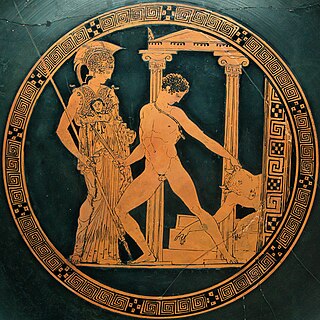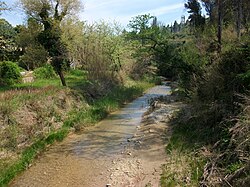
Alpheus or Alpheios, was in Greek mythology a river and river god.

Olympia, officially Archaia Olympia, is a small town in Elis on the Peloponnese peninsula in Greece, famous for the nearby archaeological site of the same name. The site was a major Panhellenic religious sanctuary of ancient Greece, where the ancient Olympic Games were held every four years throughout Classical antiquity, from the 8th century BC to the 4th century AD. They were restored on a global basis in 1894 in honor of the ideal of peaceful international contention for excellence.

Elis also known as Ellis or Ilia is a historic region in the western part of the Peloponnese peninsula of Greece. It is administered as a regional unit of the modern region of Western Greece. Its capital is Pyrgos. Until 2011 it was Elis Prefecture, covering the same territory.

In ancient Greek religion and mythology, the twelve Olympians are the major deities of the Greek pantheon, commonly considered to be Zeus, Poseidon, Hera, Demeter, Aphrodite, Athena, Artemis, Apollo, Ares, Hephaestus, Hermes, and either Hestia or Dionysus. They were called Olympians because, according to tradition, they resided on Mount Olympus.

Pyrgos is a city in the northwestern Peloponnese, Greece, capital of the regional unit of Elis and the seat of the Municipality of Pyrgos. The city is located in the middle of a plain, 4 kilometres from the Ionian Sea. The river Alfeios flows into sea about 7 km (4 mi) south of Pyrgos. The population of the town Pyrgos is 26,052, and of the municipality 45,365 (2021). Pyrgos is 16 km (10 mi) west of Olympia, 16 km (10 mi) southeast of Amaliada, 70 km (43 mi) southwest of Patras and 85 km (53 mi) west of Tripoli.

National Road 74 is a single carriageway road in southern Greece. It connects Pyrgos with Tripoli, via Olympia and Vytina. Its length is 141 kilometres (88 mi). It runs through the western and central part of the Peloponnese peninsula, in the regional units Elis and Arcadia.
Tripotamia is a village and a community in the municipal unit of Tropaia in the westernmost part of Arcadia, Peloponnese, Greece. It is situated on a hill above the left bank of the river Erymanthos, 3 km north of its confluence with the Alfeios. The Ladon, another tributary of the Alfeios, flows 2 km east of Tripotamia. The rivers Erymanthos and Alfeios form the border with Elis here. The community consists of the villages Tripotamia, Kapellitsa and Chania. The Greek National Road 74 passes north of the village. Tripotamia is 2 km east of Aspra Spitia, 6 km southwest of Liodora and 15 km east of Olympia.

The Ladon is a river in the Peloponnese peninsula of Greece. It features in Greek mythology. It is a tributary to the river Alfeios, which empties into the Ionian Sea. It is 70 km (43 mi) long.

The Alpheios, sometimes spelled Alfeiós, is the main stream of the Alpheios Valley drainage system, a dendritic type, originating on the north slopes of Mount Taygetus, located in the center of the Peloponnesus of Greece, and flowing to the northwest to the vicinity of Olympia, where it turns to the west and, after being impounded by the Flokas Dam, a hydroelectric facility, empties into the Gulf of Kyparissia of the Ionian Sea south of Pyrgos. The entrance into the gulf through agricultural land and across an unpopulated, sandy beach partially blocked by a spit is hydrologically unspectacular, with the water too shallow to be navigable by any but the smallest craft.
Smila is a village and a community in the municipality of Olympia, Elis, Greece. It is situated in the plains north of the river Alfeios, 1 km north of Strefi, 3 km west of Pelopio, 7 km northwest of Olympia and 10 km east of Pyrgos. The community includes the small village Karoutes.

The Temple of Zeus at Olympia was an ancient Greek temple in Olympia, Greece, dedicated to the god Zeus. The temple, built in the second quarter of the fifth century BC, was the very model of the fully developed classical Greek temple of the Doric order.
Plataneiko is a river in the northern part of the Achaia prefecture. It is part of the Kladeos River watershed. The river flows entirely in municipalities of Rio and empties into the Gulf of Patras.
Alpheos or Alpheus may refer to:
Aspra Spitia is a village in the municipality Olympia, eastern Elis, Greece. It is situated between the rivers Alfeios and Erymanthos, 4 km northwest of their confluence. It is 2 km west of Tripotamia (Arcadia), 4 km southeast of Vasilaki, 14 km east of Olympia and 30 km east of Pyrgos. Near the village, archeologists have excavated remains of housing from the Neolithic period. The village was affected by the 2007 Greek forest fires.
Alfeiousa is a village in Elis, Greece.
Makrisia is a village in the municipal unit of Skillounta, Elis, Greece. It is situated near the left bank of the river Alfeios, 2 km northwest of Krestena, 3 km northeast of Kallikomo, 4 km southwest of Olympia and 16 km southeast of Pyrgos.
Kladeos is a community in Elis in Greece. It is part of the municipality of Olympia. It is 4 km northeast of Olympia and 5 km south of Kryoneri.
Salmoni is a village and a community in the municipality of Pyrgos, Elis, Greece. The community includes the village Alfeios. It is situated in low hills on the right bank of the river Alfeios, at 70 m elevation. It is 2 km southwest of Strefi, 3 km southeast of Varvasaina and 8 km east of Pyrgos. The Greek National Road 74 passes north of the village. A previously independent community, Salmoni is part of Pyrgos since 1997. The current Greek Orthodox metropolitan of Thessaloniki, Anthimos, was born in Salmoni in 1934. The village Alfeios, 3 km west of Salmoni, has two churches, Metamorfoseos tou Sotiros and Saint Raphael.

The Greek Baths in ancient Olympia are the earliest baths in the sanctuary and they are situated on the west side, outside the sacred enclosure of the Altis, near the bank of the river Kladeos. They were constructed during the 5th century B.C. and continued to develop throughout their use. In the 2nd century A.D. they were used as the foundation for the construction of the Kladeos Baths. They are called Greek Baths in order to distinguish them from the baths of the Roman period at the same area.
The Hippodrome of Olympia housed the equestrian contests of the Ancient Olympic Games. According to Pausanias, it was situated to the south of the Stadium and covered a large area four stadia long and one stade four plethora wide. The hippodrome was a wide, flat, open space where the starting point and the finish line were designated with a pole and a second smaller pole called nyssa designated the turning point.










